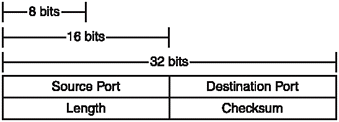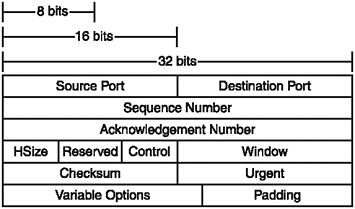Common Transport Protocols
| [ LiB ] |
As a game programmer, you usually won't pay attention to the IP protocol; the operating system should take care of that for you automatically. You'll only be slightly more interested in the TCP and UDP protocols, since most compilers have built-in libraries to handle these protocols. I'll start with UDP first, since it's simpler.
UDP
UDP, as I've said before, is the User Datagram Protocol. A datagram is basically just a single packet of data. The UDP protocol is simple and doesn't offer the reliability of more complex protocols, such as TCP. Essentially, you just send the packet out and hope it gets there. This is a "fire and forget" protocol. Figure 1.11 shows the UDP header format.
Figure 1.11. The header format for a UDP packet.

NOTE
The port fields for UDP (and as you'll see shortly, TCP as well) are 16 bits long. This means that a total of 65,536 ports are available for use. Ports below 1,024 are reserved for specific application-level protocols assigned by the Internet Assigned Numbers Authority (IANA) . To see a list of these ports, you can visit their Web site at http://www.iana.org . IANA covers things such as HTTP (80), FTP (21), Telnet (23), SMTP (25), as well as hundreds of other protocols that no one has ever heard of. You should generally try to keep your programs' port numbers above 1,024. If you are not running as root, UNIX-based systems won't even allow you to open ports below 1,024 (for servers). Table 1.2 shows a listing of common port numbers.
Table 1.2. Common Ports
| Port | Service | Purpose |
|---|---|---|
| 17 | QOTD | Quote of the day; sends a quote in text form |
| 20 | FTP | Data FTP data port |
| 21 | FTP | Control FTP control port |
| 22 | SSH | Secure Shell Terminal (a secure version of Telnet) |
| 23 | Telnet | Allows terminal control |
| 25 | SMTP | Simple Mail Transfer Protocol |
| 37 | Time | Sends the server time |
| 53 | DNS | DNS lookups |
| 80 | HTTP | World Wide Web pages |
| 110 | POP3 | Post Office Protocol; more mail stuff |
| 113 | Ident | Identifies the name of a computer |
| 119 | NNTP | Newsgroups |
| 143 | IMAP | Another old mail protocol |
| 6666 | IRC | Internet Relay Chat |
| 31415 | PIE | Pieserver; it serves digits of pi [*] |
[*] See my website at http://ronpenton.net/projects for more information on Pieserver.
The first thing you should notice in Figure 1.11 is that the header is only 64 bits long, or 8 bytes. That's pretty small for a packet header, at least compared to other protocols.
Next, notice the two port fields. You see, once a packet gets to its destination, there really is no way for the receiving machine to figure out what program the packet is trying to get to. Therefore, the idea of ports was invented. When a port receives a packet, the operating system is supposed to read the port number off the packet and send the packet to the appropriate program. This way, you can have many different programs on the same machine, all using the network connection at the same time.
In Figure 1.11, you should also notice the length and the checksum fields. The length tells you the length of the packet data, including the header. The checksum field contains the checksum of the data in the packet, so that the receiving machine can figure out if the data is intact. If it isn't, the receiver just discards the packet altogether and acts as if it never got it.
UDP is a connectionless protocol. This means that UDP programs don't connect to each other; they just send the packet, and the server is supposed to accept it. Other protocols, especially TCP, will not accept incoming packets unless you explicitly connect to the other end first.
The fact that UDP does not guarantee delivery of packets can lead to problems. In a fast-paced game in which the server constantly sends the clients updates on the positions of other players, guaranteed delivery is not a great problem. If, for example, a position update packet is sent but never delivered, a reliable protocol like TCP will keep trying to send the packet; but by the time the protocol finally sends the original packet, the player's position may have changed. So in this case, UDP is a useful protocol.
But what happens with important data? What if something happens in a game, and the game is set up so that it won't retransmit that data later on? You could end up with your clients completely missing an important game event such as a gunshot and then getting out of sync. In this case, UDP isn't a very useful choice.
For MUDs and MMOGs, using UDP usually isn't a good idea, since most things that happen in these kinds of games are event based that is, events occur once and the client absolutely needs to know they happened .
TCP to the Rescue!
TCP is probably the most highly used transport protocol, since it guarantees data delivery. If you tell your TCP library to send data, it will get there, barring any unusual events such as a nonexistent destination. Without TCP, file transfers and reliable communication over the Internet would be virtually impossible .
In contrast to UDP, TCP is a connection-oriented protocol. This means that the client must tell the server that he wants to connect, before the server will even listen to incoming data.
TCP is also a streaming protocol. This means that the protocol attempts to send streams of data, separated into packets for delivery over a packet-switched network. This is an important part of TCP, since it ensures not only that the data actually reaches its destination, but also that the data arrives there in the same order in which it was sent.
NOTE
Because of the decentralized nature of the Internet, two packets you send from one place to another may follow two completely different paths, which means that you can't be sure that sending one packet first will mean it will arrive first. This makes TCP a great way to make sure that the connections receive their data in order.
I've told you about TCP and the acknowledgement packet that it uses. Since this is important, here's a quick recap. Whenever a TCP port receives data, it sends an acknowledgement packet saying that the data was received. If the original sender never gets an acknowledgement, then the TCP port attempts to send the data again. Of course, this process is inefficient if the sender sends one packet and then waits for the acknowledgement before sending anything else.
That isn't how TCP actually works, though. TCP starts off sending all the packets it needs to in order, and just continues sending until there is nothing left to send. If TCP realizes that an acknowledgement packet hasn't come back for a packet it sent, it stops what it is doing and attempts to retransmit the packet that wasn't acknowledged .
On the receiving end, if the receiver detects that it is getting a packet out of order, it buffers the data in that packet until the packet or packets that are supposed to precede it arrive.
At the application level, all of these operations are transparent. Your TCP library handles all of this for you and makes sure you get the data in its intended order.
Unfortunately, all of these safeguards come with a price, as you see when you examine the TCP header shown in Figure 1.12. Note that the TCP packet header is much larger than a UDP header.
Figure 1.12. The standard for TCP packets.

TCP is a feature-rich protocol. It includes not only the kitchen sink but the disposal too. The minimum size of a TCP header is 20 bytes, much larger than the 8 byte UDP header.
TCP uses the same port numbering scheme as UDP, 16-bit ports, which adds up to 65,536 ports. Like UDP, TCP has a checksum field, which is used for data integrity.
The other fields you should at least note are the sequence, acknowledgement, window, and urgent fields. The sequence field denotes the position of the packet in the current stream at its transmission point; this is used so that the receiving end can piece together the packets if they arrive out of order. The acknowledgement field tells the receiver the acknowledgement number that the sender is expecting.
The window field is somewhat interesting. TCP implements flow-control mechanisms, which means that each side of a TCP connection can tell the other side how much data it is willing to accept. This is useful for preventing a connection from accidentally sending more information than the other side can handle.
Notifying the other side on acceptance limits is also particularly useful whenever there are dropped packets. Since TCP buffers data that is out of order, it may be useful for the receiver to tell the sender to stop sending data until it catches up. Buffered data can take up lots of room, since the TCP library can't do anything with that data until it gets all previous packets.
Finally, you should be aware that TCP supports a concept called urgent data, which the urgent field handles. Urgent data should not be used inside the data stream, but contains important connection and control information. The TCP library you are using should seamlessly strip this data out of the stream and take care of it automatically.
That sums up all the important things you as a programmer need to know about TCP. If you're interested in learning more about either UDP or TCP, networking books can do the trick. I just wanted you to know the basic mechanics of how these technologies work as they affect game programming.
| [ LiB ] |
EAN: 2147483647
Pages: 147